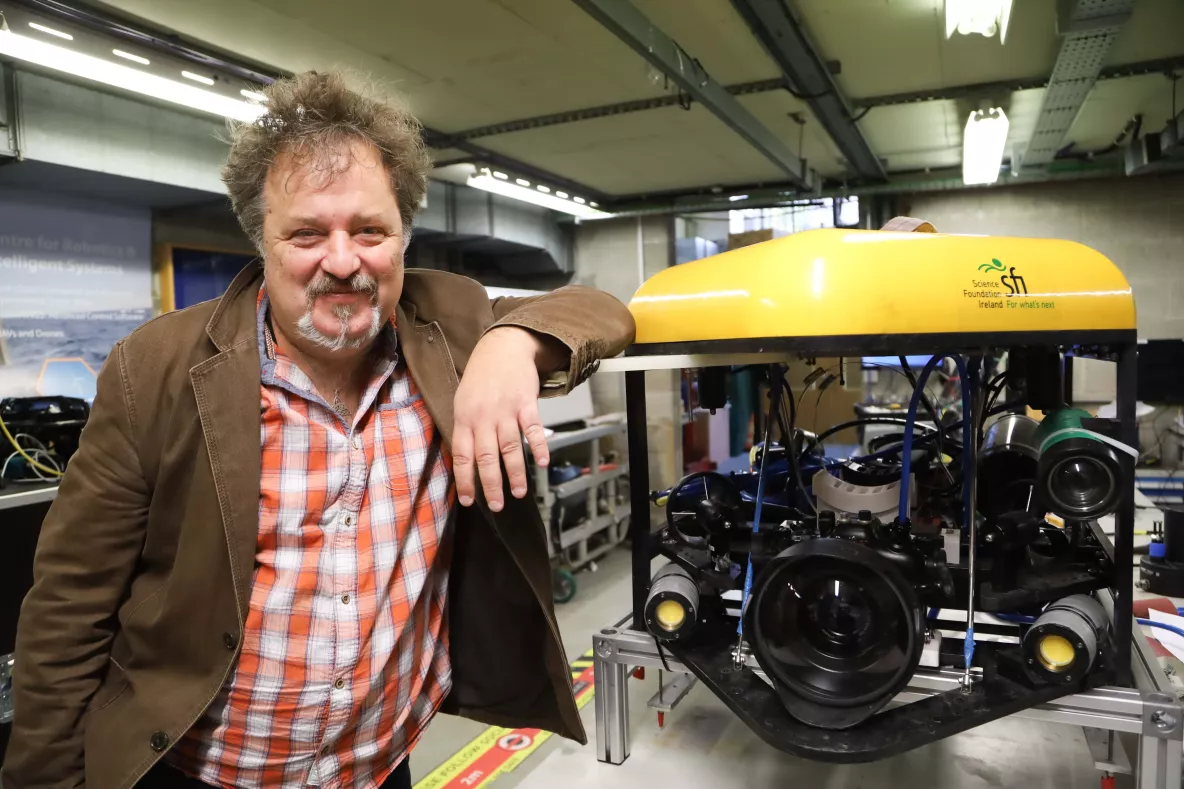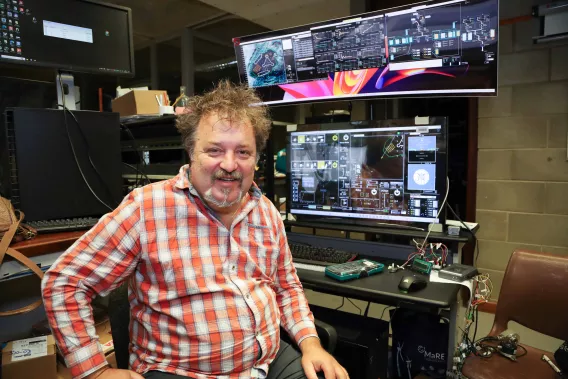

Dr Edin Omerdic is a Senior Research Fellow in the Department of Electronic and Computer Engineering and the Centre for Robotics and Intelligent Systems (CRIS) at University of Limerick.
An award-winning mathematician in his native Bosnia, Edin’s love for underwater research began when completing his PhD in the UK.
“During my PhD I made the transition from surface vessels to a subsea environment and learned a lot about underwater robotics. I designed a novel algorithm for thruster fault diagnosis and accommodation for underwater robots. At the end of the project, the algorithm was successfully implemented and tested on real robots. The first research cruise in Ireland sparked my love and passion for underwater robotics, immersing me in the fascinating world of marine exploration and technological innovation beneath the waves.”
Edin’s PhD provided the fuel to ignite his passion for both mathematics and research in this area. In 2005, he and his team started to build their first ROV and began to lay the foundations of a new software platform to test it on, a platform that would eventually become OceanRINGS. CRIS at UL is unique for a marine research centre in that it does not have a UL-based pool to test developments in ROV technology or simulate ocean environments. Necessity became the mother of invention for Edin who looked to code to bridge the gap between the development in simulated environment and real-world testing.
“In our development, we have a virtual environment and a real-world environment. These are like two rings that intersect and allow the user to stretch them and combine components between environments without needing to change the core code. The main reason the software was developed in this way is that we don't have the proper infrastructure at UL to facilitate underwater robotics. This means we need to work a lot in a simulator. After several years of development, we designed a high-quality, very realistic simulator for underwater robots and surface vessels. Now, we can test a full mission here in advance in the simulator before doing any work in the ocean and this allows us to iron out any issues that may arise in advance of the mission.”
OceanRINGS (OR) is a generic fault-tolerant ROV control system that is built to make complex subsea tasks simple. It combines state-of-the-art navigation equipment with control algorithms and emerging virtual reality technologies to allow for precision underwater movement. It provides the user with many benefits such as its ease of use and dynamic positioning system.
“The software allows even an average pilot to achieve exceptional results. Traditionally you would need many years of experience operating ROVs to complete complex tasks underwater. With OR, you don't need to be a skilled pilot to get great results in a short period of time. The programmes dynamic positioning system allows the ROV to hold its position within a centimetre of accuracy at sea.”
This ability to manoeuvre and hover at dept has meant the software has been successfully tested on many complex missions that the team at CRIS have undertaken in recent years such as monitoring an underwater gas pipeline for leaks, inspecting shipwrecks and submarines, and more recently inspecting floating offshore wind turbines for maintenance purposes.
“If you have an offshore wind turbine or structure that is floating, it is not perfectly static; it is moving depending on the tidal currents and other factors. To conduct a proper survey you need a clever solution (adaptive path following) that enables you to design a path around the structure that allows for this movement, so that when the surface moves the path will also move keeping the relative distance to one another constant. Because of this movement, wind turbines have special sensors and instruments to measure this motion. OR uses this sensor data to adjust to the ROVs path in real-time, allowing for a high-quality survey of the foundation of the structure regardless of the motion.”
One of the unique features of OR is its ability to allow for synchronisation of movement between the ROV and the support vessel at sea. During path following, the ROV and support vessel move in synchronised way with the same speed and course, allowing fast, safe and time-efficient survey of subsea structures. Another innovative feature is the next-generation HMI: in advance of a mission, 3D computer-aided design (CAD) models are created of the ship and ROV in the virtual environment. This environment is then connected to real-time measurements and this replicates the real world environment in a simulated space (mixed reality environment).
“Many ROVs are system independent in that they don’t consider connection to the ship. Our software allows for a 3D interface that permits the user to view the ship and ROV together. This allows them to move together in parallel at a constant speed. From a safety perspective, it means better management of the umbilical cable that connects the ship / tether management system to the ROV and eliminates the risk of a collision between the ship and the vehicle.”
The OR software platform will continue to develop with advances in technology and as society looks more to robotics and autonomous systems to replace manual tasks that are more labour and carbon intensive. This reality will continue to drive Edin and his research at UL as he continues to explore beneath the waves.
“It’s like working in NASA or watching a film about space exploration where you see these scientists looking at one of their rockets land on the Moon or Mars. They are watching the screen and when it is successful you can see the joy on their faces. When I work with ROVs in our virtual environment at UL in the simulator and then execute a mission at sea and everything works perfectly, for me this is a similar feeling.”

Dr Edin Omerdic pictured with the OceanRINGS Software System in the Department of Electronic and Computer Engineering at UL
Postal Address: Science & Engineering Faculty Office, Lonsdale Building, 1st Floor, University of Limerick, Limerick, Ireland
Email: scieng@ul.ie
Phone: +353 (0)61 202109 or +353 (0)61 202642